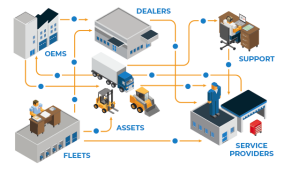The history of technology in the trucking industry has had many watershed moments. The advent of diesel engines, which had been mainly used in large stationary operations, brought a large increase in hauling power and fuel efficiency. In the 1970s, electronics began revolutionizing how those engines were controlled, again boosting their efficiency.
Today, this $700 billion industry is once more on the cusp of a technological revolution. This time it’s the industrial internet of things that is poised to drive dramatic improvement in asset performance and utilization.
One of the biggest promises of IIoT is predictive maintenance. But IIoT success requires more than just implementing technology like sensors and telematics — it requires that the technology is integrated into a connected process that aggregates, organizes, filters and prioritizes data into a usable format. There is also significant value in IIoT beyond predictive maintenance — ranging from improving the service process, maximizing the lifetime value of an asset and optimizing purchase and disposition decisions based on real data.
Connecting assets is as easy as installing vehicle telematics systems to get data regarding the condition and operation of the asset. But connecting that data with the management of that asset means connecting assets, service locations, fleet management systems, diagnostic tools, OEM data, call centers and remote service providers. This means that all the related parties in the service supply chain are able to share and collaborate, which drives dramatic gains in asset performance and uptime. Collectively using the data from vehicles to inform and enable an improved approach to service management ensures that the anticipated value of IIoT will be realized.
Today’s IIoT reality: Disconnected data, little service value
The reality for many fleets is that commercial vehicle service and repair operations are still hampered by disconnections. Management information systems are siloed and unable to communicate with each other. Stakeholders, including fleets, service providers and OEMs, are unconnected and forced to make do with data that is incomplete, incorrect, inconsistent, unstructured or out of date. This is the challenging reality of early IIoT implementations for many organizations — a flood of unusable data that hampers the service process rather than speeds it up.
How can fleets, dealers, service providers and OEMs enable IIoT to live up to its potential? They can start by fixing the disjointed ecosystem that currently exists and improving the information sharing and collaboration that is essential to enhancing efficiencies and uptime. This requires thinking about IIoT in the context of a service relationship management (SRM) tool. SRM links all the stakeholders involved in service management, ensuring the right people get the right information, in the right place and at the right time.
Realizing IIoT’s promise: Lower downtime, optimized service processes
There already is evidence that IIoT adoption can positively impact asset performance and service and repair operations. The diagnostic and analytic capabilities enabled by IIoT provide great intelligence to service teams when they are available at the point of service. In commercial vehicles, remote diagnostics allow for data collection, both as an issue is reported as well as prior to the issue occurring. This leads to greater accuracy and the ability to provide proactive support. Connected vehicle data also provides for more effective root-cause analysis and enables more robust case-based reasoning, helping address downtime, fuel efficiency, maintenance costs and service optimization issues.
One commercial truck manufacturer already equips all its vehicles with remote diagnostics that provide around-the-clock monitoring and detailed analyses of critical fault codes, enabling identification of emergent issues for action, improvements in planning for repairs, and streamlined diagnostic and service procedures. On top of this, the manufacturer has been investing time and resources into building a consistent, measurable process to improve uptime for its customers and dealers through a combination of IIoT deployment and SRM implementation — and has integrated its telematics and analytics tools into the SRM platform. The results speak for themselves: Service providers in the program have seen reductions in both diagnostic time and service event downtime (36% and 29% less, respectively).
SRM as the on-ramp to IIoT promise
Incorporating asset data in an SRM platform can provide real-time transparency and visibility and enable connected service technology that maximizes uptime and reduces costs across an entire service ecosystem. Further, when advanced data analytics are layered on top of high-quality, consistent data delivered by IIoT, it can provide insights that inform service process improvement for stakeholders across entire service supply chains.
A connected service process allows everyone involved in service events to effectively communicate and collaborate. Assets return to service more quickly, increasing profitability.
An SRM tool unifies those supply chains to improve uptime, ensure consistent network-wide service delivery, create and strengthen customer relationships, reduce warranty and support costs, and lower goodwill expenses. Using an SRM platform addresses the four C’s of effective service event management:
- Connectivity that facilitates seamless data flow between assets, service points, OEMs and fleets;
- Communication that enables contextual information sharing and collaboration at the point of service;
- Controls that provide tools to reduce risk, increase efficiency and improve decision-making; and
- Consistency across service networks and repair processes, including shared service histories for real-time decision support and post-event reporting that drives accountability and process improvement.
The commercial trucking industry is a critical part of the U.S. economy — the American Trucking Association estimates it moves about 71% of the nation’s freight by weight. Using IIoT to improve its efficiency promises to spread beneficial affects throughout supply chains for industries as diverse as food production, manufacturing and retailing — all while improving the bottom line and building strong customer relationships.
Author: Rob Bradenham, Decisiv
